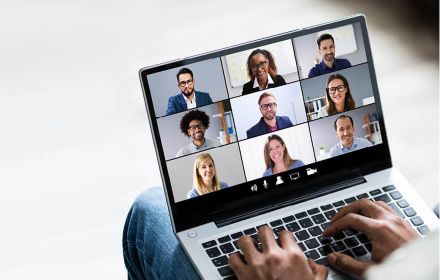Design the right workforce approach to deliver your strategy. Put initiatives in place to attract and retain key talent, develop required skills to keep up with market dynamics and build professional teams that share your organization’s values. Embrace your future-proof organization with the proper technology, data and metrics. Today’s worker expects relevant, heavily tailored, more meaningful experiences and engagement that not only meet but exceed demanding expectations.

Change management
Change management can be a delicate process. Without the support from the stakeholders involved and leaders, it can be challenging to ensure a successful transition to the new desired target state, such as technology adoption, new ways of working, a reduced cost based or a cultural shift. How should you manage change in an agile way? How can you use data more effectively to deliver transformation? What would your leaders need to do to support an important transformation?
A structured approach, incorporating design thinking and persona-based experiences as well as behavioral science capabilities, can help change to happen and stick.

Cultural change
Your organization’s culture is rooted in shared assumptions about your workforce’s values, norms and behaviors, which determine the response to internal and external challenges.
Wherever there is a gap between your people's personal values and behaviors, and those that your organization wants to represent, you’ll find opportunities to undertake a culture transformation process.
Aligning your culture with your organization’s strategy ensures that your organization and your people work in harmony, which positively impacts your internal operations, stakeholder relationships, and your overall business performance.

Digital HR
Successful HR Transformation is built on three capabilities: Transformation, Technology, and Change, with Employee Experience underpinning all three.
Over the past 20 years, we’ve seen the growing digitalization of HR as Cloud HR, social media, big data and HR analytics, AI and robotics, to name a few key trends. It’s fair to say that recent technology has revolutionized the workplace, including the HR department, bringing new tools and more efficient processes. But technology alone does not drive results and your HR department must continue to develop the skills and knowledge to keep up with the pace of change and stay competitive.

Employee experience
An organization’s success depends on its ability to shape the workforce of the future, nurture a purpose-driven culture and design a “consumer grade” employee experience that is relevant, heavily-tailored, and meaningful.
The workforce is becoming more diverse, while people are also living longer and have longer careers. Different generations have differing needs and expectations from their employers and customized experiences for employees are fast-becoming an essential part of HR design.
HR leaders recognize the importance of discovering new ways to attract and retain the best talent by creating a positive employee experience. A clear plan is critical, with appropriate actions to align your value proposition as closely as possible with your employees’ expectations.

Future of HR
Today’s dynamic business environment requires a fundamental re-think of the HR role. How can HR prove its relevance within your organization and bring strategic value to your business? How can technology be appropriately used to truly understand the needs and motivations of your employees? How can HR design a positive employee experience that keeps pace with their evolving demands?
COVID-19 has shown that people are the number one priority for nearly every organization around the world. In response, HR leaders find themselves at the forefront of re-shaping the way work gets done. This presents an opportunity for the HR function to switch from firefighting immediate pressures to strategically engineering a successful future. There has never been a more exciting time to be in HR.

HR service delivery model
The world around us is transforming faster than we think. HR roles are changing, and technology is defining the path ahead. The traditional operating model of many HR functions, often based on the Ulrich model, is ripe for innovation. As the scope of HR shifts, your service delivery model needs a significant re-design to stay relevant.
Prolific availability of data, digital technologies and the ability to deliver services virtually are catalysts for fundamental and ongoing changes to your HR service delivery model. Navigating this change successfully will empower your HR function to find new ways of delivering value to your organization, as you move from standardization to customization and consumerization.

Leadership
Leaders are vital to the success of implementing change programs at every level, but they need to manifest specific qualities to deliver these changes. No matter the scale of your organization, there are critical capabilities and personal characteristics that enable leaders to successfully embed and sustain change. These capabilities can be learned but may be challenging to qualify without a clear skills framework and learning approach. Your leadership team should keep developing their change management skills, so that your organization can confidently deliver, embed and sustain the change you need for your business.

Organizational health
When was the last time you undertook a health check on your HR organization? Doing so means considering multiple areas, including your HR service delivery model, HR processes, wage tax and social security compliance, legal compliance and/or opportunities or pensions. The health check can be performed via a HR scan, which can offer very valuable information and allows you to have the relevant context you need to assess the status of all employee-related matters. If non-compliance issues are detected, these can also be quickly addressed and solved. Efficiency and maturity assessments, which critically analyze your current HR processes and organizational set-up - while being compared to other market leading practices in the HR domain - can offer a valuable benchmark guiding future strategy, efficiency improvements and identifying ways to make the most of any optimization opportunities.

People analytics
People analytics can be applied to different sources of structured (HR master data) and unstructured data (CVs, performance reviews) to identify, extract, interpret and visualize meaningful patterns to provide advanced insights. As organizations generate increasing amounts of data, the options for analysis can be overwhelming and knowing which insights will be most helpful to your agenda can be a challenge. Using People analytics tools is the difference between an organization making educated guesses and making fact-based decisions about their people and their experience.

People aspects of transformation and M&A
As your organization goes through different types of change - such as mergers & acquisitions, integration, separation, and carve-outs – it requires major HR organizational transformation and entails an enormous adjustment for your personnel and stakeholders. This can ignite a spiral of uncertainties and questions that trigger stressful dynamics for everyone involved.
To make the transition as smooth as possible, it is crucial to maintain focus on every step of the way, precisely structure change management, dive deeply into cultural integration initiatives and underpin the entire process with solid leadership support.

Workforce shaping
Workforce-shaping means having the right people, in the right place, at the right time. With the arrival of automation and artificial intelligence, organizations in every industry are exploring and trying to understand the advancing integration of humans and machines in the workplace, as well as how to effectively combine the best of each.
Connecting business strategy, workforce analytics, innovation and your HR agenda will help you understand the long-term requirement for people and skills in your organization, so that you feel prepared for whatever the future brings.
Read more
Explore more insights on HR Strategy & Change
- Shaping the employee experience
- Reinventing work with a digital mind-set
- The 2020 lessons for HR
- The future of HR in the new reality
- The Future of HR: Lessons from the pathfinders
- Shaping workforce insights through data
- Why Culture is more important than ever
- Moving towards a digital finance organization
- The Future of Human Resources 2020
- Podcast series for global mobility leaders







